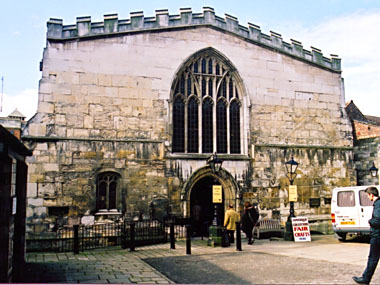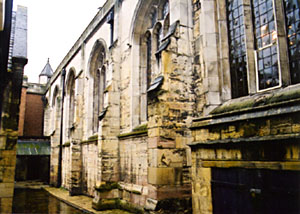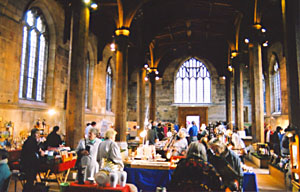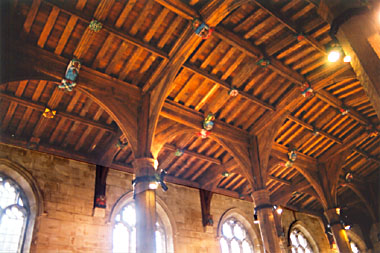
East (main entrance) end of York's guildhall
Photo © S. Alsford
A community hall that served for assembly meetings was in existence at York before the mid-thirteenth century, and was explicitly referred to as a guildhall in the royal charter of 1256. Its site is unknown but may have been the same as the Guildhall known to exist by the beginning of Richard II's reign, sitting on the northern bank of the Ouse. There is some indication that site was earlier the residence of a leading citizen active in efforts during the 1170s to obtain self-government in the city; it is not inconceivable the house could have been a meeting-place of townsmen working towards that end, and in due course found its way into civic hands, perhaps through the agency of the merchant guild of which we hear during the early twelfth century.
The shell of the present structure is a replacement, whose construction got underway in the 1440s; the new hall, 96 feet long and 43 feet wide, was sufficiently complete by 1459 for it to be used for a council meeting. Badly damaged by incendiary bombs during the Second World War, the hall's wooden roof, its supporting pillars, and the painted decorative bosses are reproductions of the medieval originals.
The bureaucracy, and day-to-day administration, of the city were housed in a building on the Ouse Bridge (for more information see the "York at the close of the Middle Ages" page) built as a chapel (ca.1200). Part was known as the Tollbooth, indicating its use as the point where customs on river commerce were collected – the main landing place for goods being at the opposite end of the bridge. By the late fourteenth century it was being referred to as the mayor's chamber, or the council chamber, for here the city council could meet in some seclusion.

The two photos above (south side, exterior) and
below (interior, looking towards the east end, during a crafts and
antiques fair) give a sense of the depth and capacity of the hall.
Photos © S. Alsford

A larger building was needed for assemblies, and this was the purpose of the Guildhall. Here took place elections of mayors, their swearing-in ceremonies, and the commons' oath of loyalty to the new mayor. The earliest known procedure was for the mayor to nominate two or three aldermen, from whom the assembled community would make its choice; but during constitutional tinkering of the last decades of the fifteenth century, the reverse emerged: representatives of the craft gilds offered nominations, and mayor, aldermen and council made the final decision. Whether this was an attempt by reformers to shift power downwards or, conversely, was seen by the ruling class as a better means of controlling the outcome, or was simply an effort to bring York in line with London practice, we are not sure.
Although created as a public building, even the Guildhall (both the pre-1447 and post-1447 versions) had an adjoining room &150; at the river end in the case of the post-1447 version – into which city officials and councillors could retire for private counsel or deliberations. But even the relatively capacious Guildhall had its limits; in 1504, during a period when community tempers were high over the issue of access to common land, on the day when nominations for mayor were supposed to be submitted by the community, a crowd of 3,000 essentially blockaded the mayor and aldermen within the Guildhall, demanding their concerns be addressed before they submit their nominations.
The city court – or burghwarmote (townsmen's moot) as earlier known – may also have met either in the Tollbooth or in the Guildhall, depending on requirements. After the mayor and aldermen had been granted powers of commissioners of the peace (1392), the city court with expanded jurisdiction met in the Guildhall, as frequently as needed.

The guildhall roof structure and decorations.
Photos © S. Alsford

During the fifteenth century York's political administration comprised the executive officers (mayor and sheriffs), an elite of 12 aldermen, a council of 24 recruited primarily from ex-sheriffs, and a lower council of 48. The last was only summoned to meetings dealing with important political business, such as decisions on major expenditures or the passing of important by-laws, to ensure the community at large was represented and had theoretically given its consent. Concerns of the populace could be brought forth, but in the decorous form of written petitions, mimicking parliamentary procedure. Routine administration, and effective decision-making, fell to the inner circles. Even then, average attendance in the last decades of the century, when records of meetings are regularly recorded, was about half the total number of possible participants, prompting the imposition of fines on absentees.
At that period there was still at least some sentiment within the community advocating more popular say in government. Taking advantage of the assembly summoned for the mayoral election in February 1475, a petition in the name of the entire community was put forward asking that, in view of decreasing city revenues from rents on communal property, only qualified men be appointed to the offices of bridgemaster and chamberlain (responsible for administering revenues). This advice to their "lords and masters" was justified on the grounds that
whereas we are all one corporate body, we consider that all of us of the community, [even] those who have not held any office in the city, are equally privileged [to participate in decision-making]
[York Memorandum Book A/Y, vol.2, p.246, my modernization].